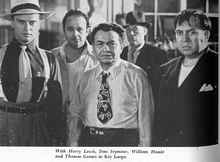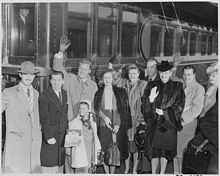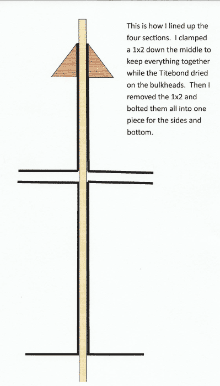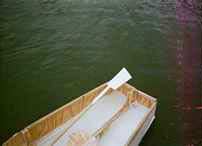
 Custom Search
|
|
| sails |
| plans |
| epoxy |
| rope/line |
| hardware |
| canoe/Kayak |
| sailmaking |
| materials |
| models |
| media |
| tools |
| gear |
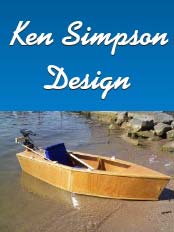 |
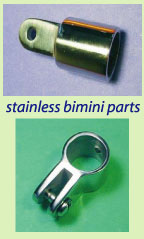 |
| join |
| home |
| indexes |
| classifieds |
| calendar |
| archives |
| about |
| links |
| Join Duckworks Get free newsletter Comment on articles CLICK HERE |
|
|
| Out There |
by Paul Austin - Dallas, Texas - USA April Love - Part Two |
 |
Part One - Part Two - Part Three Now I've begun to build April Love. However, these gangsters came by to steal my boat. They want a ship to run jungle rum from Key Largo to Texas. I took a picture of them just before they said, 'You dirty rat. You're building this boat but we're stealing it right under your nose. Just like it was Fort Knox. All right then, come out with your hands up and your bank account down. We know where your relatives live. We have our ways of making you talk.'
But I didn't panic. I knew I had what it took. I knew I could call in a higher power - Deputy Fife.
When those gangsters left to get back to Key Largo, the Duckworks Social Networking Department showed up looking for free pizza. They were too late for the pizza, Deputy Fife confiscated all relevant clues to the case. But they're fun folks, anyway.
As I live in an apartment, I don't use power tools and I can't use epoxy. So I need a boat I can build by hand. As Ken Simpson has designed it in small parts put together, it's not hard to get the cuts straight. I just take it patiently, a few cuts and pieces glued together one day a few the next. I don't get tired, and I can check what I've done every day. It's one of the advantages of Ken's portable boats. And it can be built in the small space of an apartment. I built April Love (AL) in one corner of my living room, on top of a folding table. Hand saw cuts, clamps instead of screws and Titebond in a bottle. The designer Ken Simpson calls it 'a universal boat,' and he's right. You can build it at 7 1/2 feet up to 10 feet. It has the classic shape of good boats. As you look at the first page of the plans, you'll see the fullest width a bit forward so that most of the waterline releases the water under the hull. This is how rowboats were designed before glue. With the straight stem and stern, this little beauty gives you all the waterline it can. This is one reason it can float 275 pounds within 8 feet of waterline. It is an easily driven craft. It doesn't take much effort to get it started with oars, paddle or sail. If you like to fish but most 8 footers sit too deep in the water for you to enjoy yourself, April Love is for you. And with the aft compartment, I can bring stuff like drinks, a jacket, food, a camera or a life-jacket. You could even leave the top off the aft compartment as a place for your pet. GETTING STARTEDPlansThe key to Ken's portable boats is the parts are mirror images of each other, not duplicates. This means the chine logs go on one side of the plywood for the right side sections, on the other side of the plywood for the left side sections. The plans will remind you of this, just don't make the natural mistake of building four bulkheads the same - two won't work. It's really the only significant difference from any other method of building but you have to keep this in mind. You aren't building on frames and a strongback. The bulkheads strengthen the boat, so every part you cut goes inside the boat. Here we are, on the grandeur of my balcony porch. I've given the servants the day off. Now this is how little plywood I wasted cutting two of the three sheets of plywood. This is as this boat is in short sections, Ken can lay them out differently than he could with other designs. You can't have such short sections with lapstrake. I spray varnish on the part of the wood pieces which face inside, to eliminate wood dust and splinters and edges chipping off. With the bulkheads, I glued the side frame pieces on first, leaving off the bottom frame piece. I did this so I would be able to clamp the side panels to the bulkheads at their top and bottom. This way I only used 2 nails to glue the side panels to the bulkheads. I do this to the transom, too. I've got more clamps than Carter's got Little Liver Pills, so buckaroos, I'm clampin'. There's something macho about clamping glue down and walking away to turn my Sergio Mendes LP over. It's a '60s kind of thing. Ken says more than once on the plans to keep the bulkheads and panels square to 90 degrees at their corners. This is easily done, but the reason is that with straight and square panels you don't need any more than four bolts to keep the panels aligned and flat on each other. If the angle at the panels to the bulkheads is not 90 degrees, you'll need more than four bolts to bring it together you'll be making additions later. This is one boat that doesn't look good when it's out of alignment. That also means the bolts get too tight to be removed easily, cracked plywood and water spurting up between the panels all over your pants. Not good. This is the four sections sitting up but not bolted. I'm going to recommend putting the bulkheads on, fore and aft, of all four sections. Then I think you should clamp all four sections together. This will tell you how tight the four sections come together. This will also help you keep everything at right angles when you put the side pieces and bottom pieces on. I will recommend putting on the reinforcement stringers, drill the holes through and bolt it or clamp it before you put the sides and bottom on. This way you'll find out how square the sections are before it's too late.
When you see the plans, you'll see a short stringer, vertical between the stringers along the bottom and top of the side panel. It might look like it isn't needed, but this is the anchor for the bolt assembly, so put it on without any back talk. Now here I've made some progress, beginning the slop job of paint. I used oil based paint - what a mess. Now here I've got the masts in place, just for a bit of dreaming. I tried out a seat idea, but later decided it was too much in the way for what it might do. Oh well, the best laid plans of mice and lice don't always get you the cheese. Here I have all four pieces in the balcony closet. This gives you an idea of how compact and useful Ken's designs are. All four pieces fit in my Lincolm Mark 8, so off I go to the lake.
I decided to remove the seat, make a removable seat which will fit side to side. I've still got some painting to do. I've made the sails, masts and spars, so next article will be the board, rudder and photos on the raging seas of White Rock Lake. |
